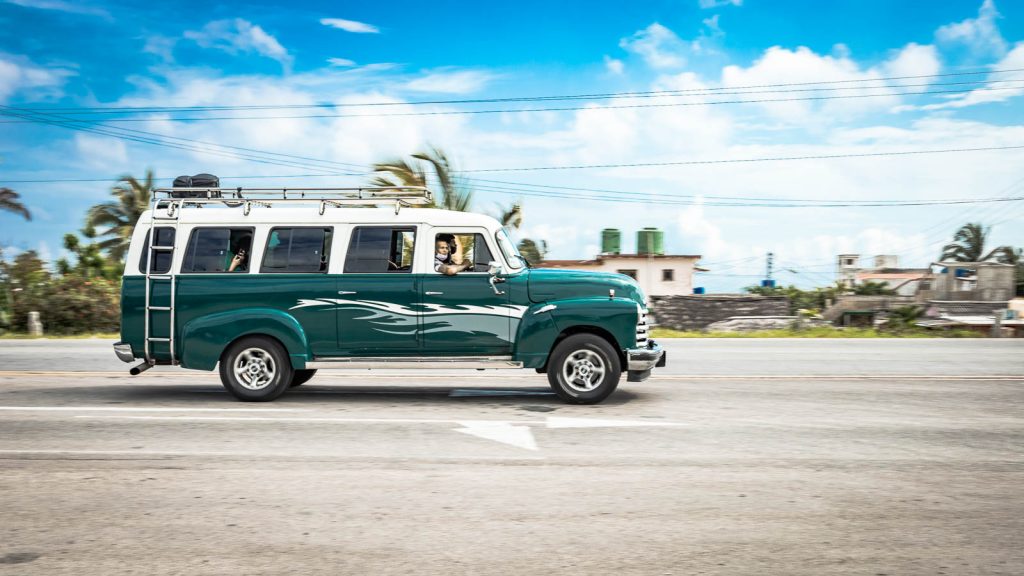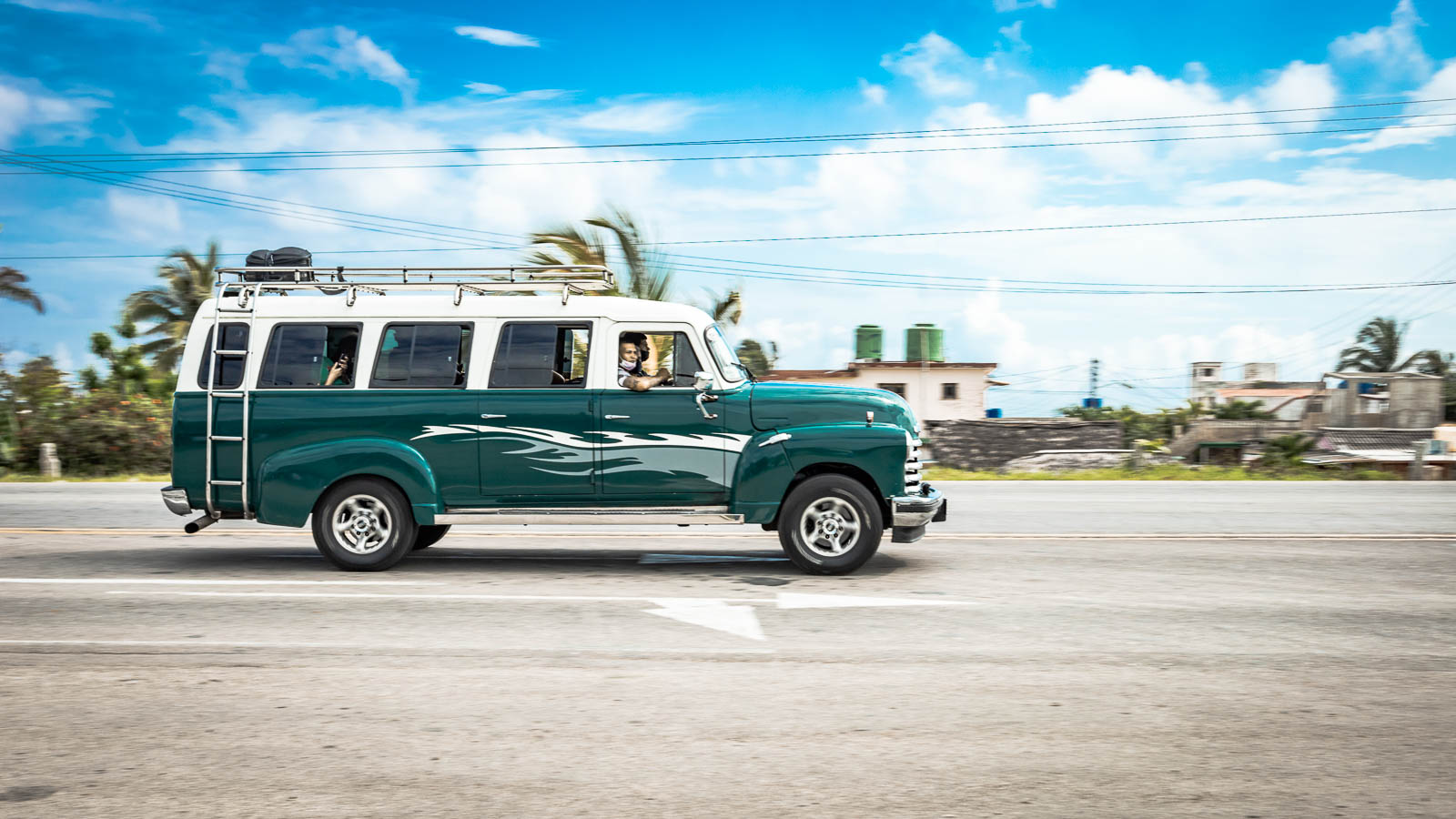Canadian Travel to Cuba in 2022 with Photography Tips
In May of 2022, I had the good fortune as a Canadian to travel to Cuba for a week with my family. Staying in the ‘Tourist friendly’ Varadero, it was a great opportunity to expose my kids to foreign travel in a safe and predictable way, while having the chance to do some sightseeing and expose them to Cuban culture and some family history.
As a photographer, this choice certainly limited exposure to the ‘real Cuba’ however. Additions to your portfolio are likely going to be minimal from this first trip, but if you’re keen – you really can get a feel for the country, and capture some incredible images along the way! Keep reading if you’re interested in a little of the experience, what to expect if you travel to Cuba and some of the issues you’ll experience domestically, as well as in Cuba. First – I’m going to cover the ‘Getting and Being there’ items, and then, the photography items. If you haven’t been before – take a moment to read it all!
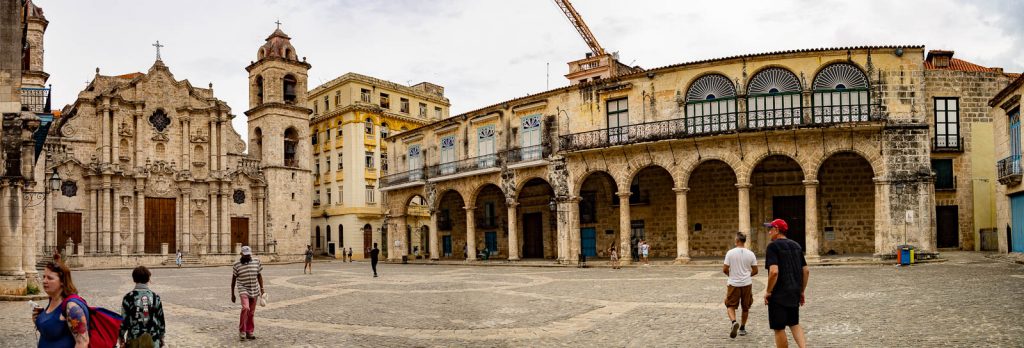
Understand the Politics and History of Cuba, and let it guide your expectations
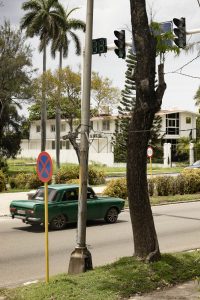
The nation of Cuba has a bloody history of invasion, colonization, cultural exploitation, national pride, and difficult choices. There are some valuable books that can provide clues to this history. [Havana – Mark Kurlansky]
The Cuba of 2022 is directly tied to the Revolution of 1958. Political instability, interference for decades by the United States of America, corruption and a rapidly widening wealth gap gave rise to a ‘nationalist’ identity, in which Fidel Castro led a ramshackle group of social thinkers to overthrow the corrupted government.
It is clear now, that this group was ill prepared to guide an island nation to prosperity, and with the embargoes placed on Cuba after the revolution in response to the end of a tax-free cash-machine for the US, the revolutionary government created ties with the only global power in a position to support them – the Soviets.
The result reduced wealth disparity between Urban and Rural citizens, but both now poor. Rural poor who have not progressed financially are now able to read and write, and have some form of educational standard, some form of medical support, and some form of standardized income. Urban citizens have some form of employment, education, medical, and income, but never enough.
Cuba suffers in 2022 due to a government built by the revolutionaries, with huge Nationalistic Pride in the Revolution. Propaganda is rampant – espousing the greatness of Castro, Guevara, and the modern ‘saviours’ of Cuba. The romanticised view of Guevara in particular is deeply rooted in north american culture, but most Cubans view him as a murderer with a ruthless ego. As a result – the Cuban government consistently tries to corral the world view of the citizens, lest the public see the reality of the Cuban experience in a more ‘global’ context.
The fall of the Soviet Union dissolved the support for Cuba from the eastern bloc. Once a key supplier of food, equipment, and labour, Cuba now sources product from any country willing to engage with them. In 2022, goods in Cuba are nearly all sourced from eastern Europe, or the Arab world in Iran. Products from Spain and Germany are occasionally available, and many goods come through Venezuela due to the strong latin ties with Central America. The US embargo on Cuba prevents many ‘basic’ products from being available in the country, and since the average Cuban income is so low – most are ‘luxury’ items anyway.
As a traveller, expect to experience shortages of things not produced in Cuba directly. You won’t find Coca-cola, but you’ll find Refresco (Tu Cola is a better cola by far!) and the ‘Ballpark franks’ you might be used to are a world away. Chicken fingers aren’t a likely menu item, and often neither is salt. (Or a kitchen item for that matter.)
All-inclusive hotels tend to have huge availability of quality food and beverages, but the average Cuban must work much harder for even a fragment of what the hotels offer. The entire tourism industry in Cuba, and all of the money to create it is Government sponsored. The revenue from that industry directly supports the financial capability of the government to procure product for sale in the country. So just as the government suppresses free-speech, and limits visibility to the outside world, it is also the only means for product to enter the country to be sold to the population. It’s a strange system – but that’s what they have.
How to handle Currency and Availability to Money when in Cuba
Over the last 40 years, the Cuban government has worked through a number of Currency scenarios, and as recently as December had multiple currencies in place (MLC, CUC, and CUP) to be used by Government, Tourists, and the common people. As of January 2022, the system has again shifted to a more practical approach, with a single ‘digital’ currency for government purchasing amalgamating CUC’s, and a ‘street’ currency used by Citizens and tourists alike.
The application of this system is confusing to say the very least, so here is a quick guide.
Moneda Libramente Convertible
MLC or “Moneda Libramente Convertible” is used exclusively in Government ‘MLC Stores’ to sell government acquired goods to citizens. This currency exists only on MLC cards, through the banking system. Funds added to MLC cards are also ONLY external currencies (USD, CAD, EUR, GBP, etc.) This monetary form ensures that there are funds available within the Government to purchase outside the country in a globally accepted currency.
Tourists will never see or use this currency. The only stores that accept MLC are for residents, and the only way to get or charge an MLC card are restricted to residents. Cubans use foreign currency to load cards, which can then be used at MLC Stores to buy goods purchased by the government for citizens.
The Cuban Peso (CUP)
Accepted nearly everywhere is the Cuban Peso (CUP). It is pegged to the US dollar for valuation, and the official exchange rate varies daily from between 19 and 24 pesos to the USD. This currency is the most common, and the most variable. While the currencies are valued in US Dollars, in most cases (aside from blackmarket exchange) US dollar cash is not widely accepted. In my experience in Cuba – travelling from Canada, the single most valuable currency is indeed the Canadian dollar. The Euro has higher value, but not as high as the current CAD to EUR rates. Now, the surprises.
Exchanging Currency
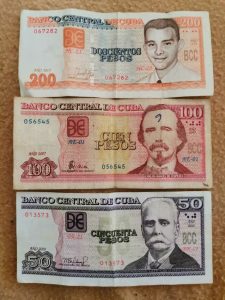 Do NOT exchange currency at a Cuban bank. As you move around ANY tourism friendly area, you will find that tour operators, your hotel staff, and indeed nearly any person on the street will exchange CAD or EUR for CUP. While ‘illegal’ it is often the only way for Cuban citizens to procure MLC allowing them to shop in the government stores – which actually HAVE things like shampoo or toothpaste, frozen meats, pasta etc. The prices on these items are indeed quite reasonable – there is no gouging in the Government store – however, access and availability to those stores has created a secondary market – a black market – often referred to as ‘on the left’.
Do NOT exchange currency at a Cuban bank. As you move around ANY tourism friendly area, you will find that tour operators, your hotel staff, and indeed nearly any person on the street will exchange CAD or EUR for CUP. While ‘illegal’ it is often the only way for Cuban citizens to procure MLC allowing them to shop in the government stores – which actually HAVE things like shampoo or toothpaste, frozen meats, pasta etc. The prices on these items are indeed quite reasonable – there is no gouging in the Government store – however, access and availability to those stores has created a secondary market – a black market – often referred to as ‘on the left’.
This will always be done ‘out of sight’ either in a private room, or secreted to you in a folded document. It is NOT done in the ‘open’ though it is widely done. Be discrete, and off the street. Many ‘black market’ street money changers will request that you pop into a private home to do this. This isn’t recommended because you could be robbed, rather, your safety in many buildings in Cuba is at risk because of the disrepair. Staff at the hotel and your tour operators are your best source, despite a lower rate.
This does create a significant inequity. Those with family outside Cuba often receive ‘remittances’ of outside currency, which they convert to MLC at 1:1, for use in the MLC Stores. Those without – tend to offer great exchange rates through a gritty hustle, in which they sell goods purchased at the MLC with a huge markup in CUP to locals, and then use the CUP, to exchange for foreign currency to fund their MLC purchases! It’s indeed a hustle, and for many – it’s the only strategy to generate wealth.
Typical Rates:
- Bank/Exchange rate: $1 CAD = 19 CUP
- ‘Hotel staff’ or ‘Operator’ rate = $1 CAD = 50 CUP
- Black Market (Street) rate = $1 CAD = 100-125 CUP
Bills are typically in the following denominations (colour front/back):
- 5 Pesos (Green/Light Green)
- 50 Pesos (Dark Purple/Purple)
- 100 Pesos (Pink/Rose)
- 200 Pesos (Orange/Brown)
So – when you arrive – have some $5 CAD bills for ‘bigger’ tips, and some loonies or toonies. One thing to note – only bring 10 or 20 dollars in $1 and $2 coin. Citizens cannot deposit these in the bank for MLC. They are often ‘collected’ and sold back to travellers at hotels for a ‘fair’ exchange. I bought $35 mixed Canadian and Euro coin at my hotel from my close servers (Shout out to Alex!), and paid $40 EUR paper currency as both a courtesy and a tip to my friends.
Typically in the hotels – you’ll only want to buy $20 or $40 (at MOST) at 50 CUP to the dollar. You’ll receive a mix of 50, 100, and 200 CUP bills. I say ‘at most’ because 2000 CUP is certainly enough for ‘little things and tips’ and you’ll likely pay CAD or Credit Card for more substantial items.
Lastly – when you LEAVE Cuba – do it without CUP in your pocket. You can’t take it with you. (Foreigners are limited to 2000 pesos leaving the country – about $40 CAD. And you can’t exchange it for any other currency, anywhere, including Cuba. Exchange ONLY what you’ll need for an afternoon – because if you do need more – it’s not hard to find it in any major centre where tourists can be found.
Prices for Goods
In almost all ‘tourist stores’ you will see pricing in dollars (assumed to be USD). If they have a credit card system – you must use a card from a NON-US bank. I know my Scotiabank VISA worked, and was charged in US dollars (then converted to Canadian on my statement.)
In ‘local’ shops prices will be in CUP. Keep your eyes open. Some shops will charge a black market rate converted to CUP, others, a ‘real’ price.
In one restaurant – a full lunch of chicken and rice with veg might be 180cup, and next door, it could be 2300cup, or 18 EUR. You have to look closely. Everyone has a hustle. It’s a fact of life in Cuba. Let your conscience be your guide. It’s not about ‘ripping you off’ – it’s often a matter of survival.
The straw hat on the beach isn’t ‘worth’ $20. But – it’s $20 and you’re on holiday. Might make the sellers day.
Availability of items is also a consideration. Some items simply aren’t available. Milk is virtually non-existent outside powdered. Salt supply ebbs and flows, and even Cuba produced Cola can be hit and miss. This is a country where ‘hustle for what you need, and take what you get’ is the standard. Even beer is available, but usually only at MLC stores, making it a luxury. This is a category where ‘results may vary’ is a law, not a suggestion.
Tipping and Gratuity
Keeping in mind – the average rate for conversions is 50-100 cup to the dollar, a common tip is really a personal decision. We often left 50 or 100 pesos for servers, or when leaving a table at the all inclusive bar.
At your hotel – tipping can indeed take another form. Gifts from outside Cuba are nearly always welcomed. On our first day, we left a note in a conspicuous location thanking the staff for their service, and taking care of us while we visited their country. Along with the note, a selection of small items (from the dollar store at home.) Things like packs of gum, toothpaste, bar soaps, feminine hygene products, hairbrushes, instant coffee, chocolate bars, a multi-bit screwdriver, lightbulbs – all items that are ‘mundane’ in Canada – are things that are either in short supply, or are simply unavailable in Cuba.
Customs and Immigration in Cuba
I will leave it to you the reader to do your homework, but here is the ‘high water mark’ for immigration and tourist entry. If you’re with a recognized carrier (Air Canada for example) your visa and paperwork is likely included in your trip details. Papers will be provided prior to landing. You should absolutely register with the Cuban tourism site (ask your travel agent). Walk on the right side of the line – this is a country with a strongly socialist lean… I wouldn’t call it communist, but has the historical remnants of that Soviet era connection.
Do NOT take a blade or weapon of any kind with you, electronic cig’s are not permitted. You can chance it – but it will likely be spotted and confiscated. Illicit drugs are 100% NOT allowed. If you’re caught – it’s Jail. Ensure you have the labels on prescription medications, and it’s fine. Don’t take alcohol. They have plenty.
Most important – be PATIENT and reasonable. You’ll walk off the plane into 1983, and you’ll then go to Moscow 1977 immigration. When you exit the building, you’ll be in a very tropical, very second world country with some of the warmest, and most hard-working people I’ve ever met. If you’re lucky, there will be a bus waiting for you for your hotel, and you’ll get a soft seat, and a cold beer for the drive!
Benefits of a Tour Operator for your Visit
Transportation is difficult in Cuba. Busses do operate around the country – but as you might imagine with scarce fuel, and limited funds, they are hard to get aboard, and scheduling is merely a suggestion. Staying in private homes is possible, but difficult to pre-arrange due to the nature of internet and communication into the country. This is not a place where Air-BnB is really an option.
When you travel to an all-inclusive – whether in Havana, Varadero, Punta Blanca, or Pinar del rios, you’ll have access through your travel operator to excursions and opportunities. The cost for these tours is quite reasonable, and while you’ll have a ‘tourist’ experience, they are rewarding and generally very enjoyable. For our family of four to visit Havana for a day by tour-bus from Varadero (About 16 hours all in), we paid around $400 CAD. Most tours run from $50-$150 (USD) a day, and are booked with a rep in your hotel. On a personal note – I can’t say enough about Air Canada on this one – despite the nightmares of 2022 air travel. (We were stranded in Cuba for an extra day due to a plane malfunction… Air Canada secured hotel space at a 5-star all inclusive for ALL of the passengers, and handled all of the airport and hotel bills and transfers. The very best result for an unpredictable situation. (Shout out to our personal tour rep Camilo!)
When you go the operator route – it really is a well-oiled machine. As stated earlier – tourism is a mainstay of the Cuban economy. Hotels do their very best with limited resources to make every stay the best it can be in Cuba. Your tour-operator and their in-country representatives will enhance the experience. Most of these representatives (for Canadian operators) will speak English and French well, in addition to their native spanish of course.
Culture and the Cuban People
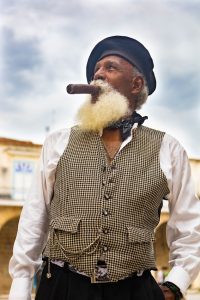 There is a radical duality to people in Cuba. They are a warm, inviting, courteous, hard-working nation. They’ve struggled for the last 60 years to make ends meet, to progress, to strive for more – all while enduring embargos, threats to sovereignty, poverty, and more. At the same time, they understand that to move forward, they must embrace the hustle, to work the ‘grey’ areas, or in many cases – simply leave their island behind seeing asylum or a new life in another nation.
There is a radical duality to people in Cuba. They are a warm, inviting, courteous, hard-working nation. They’ve struggled for the last 60 years to make ends meet, to progress, to strive for more – all while enduring embargos, threats to sovereignty, poverty, and more. At the same time, they understand that to move forward, they must embrace the hustle, to work the ‘grey’ areas, or in many cases – simply leave their island behind seeing asylum or a new life in another nation.
‘Escape’ to the US is for many – certainly the youth – a life goal. Those of us outside Cuba see the issues clearly, and the threats to North American countries from illegal immigration – but for Cuban’s – it’s worth the risk.
Others – simply work the system. They get in front of the tourists who bring much needed cash to the country. That said – you’ll never be a risk. The same person hustling you to ‘change the money?’ would likely give you the shirt off their back if you needed it. Crime is small, and tourists are generally more safe in Cuba than they are at home. There are no firearms, minimal vandalism, virtually no visible drug problems, and almost no homelessness. The existence is meager, but happy. The disdain for the government comes in the form of frustration and anger about access to the seemingly simple things – like milk. Walking alleys and streets around Parque Central in Havana felt – and likely WAS safer than doing so around Jasper Ave in downtown Edmonton.
A smile and a ‘no thank-you’ or ‘no gracias’ is nearly always enough to end any attempt to get you to change money, and you’ll never be asked for a handout. Most who approach you about currency – or to recommend their friends restaurant (ha!) speak broken or passable English. A smile and ‘no thank-you’ will generally be enough for you though!
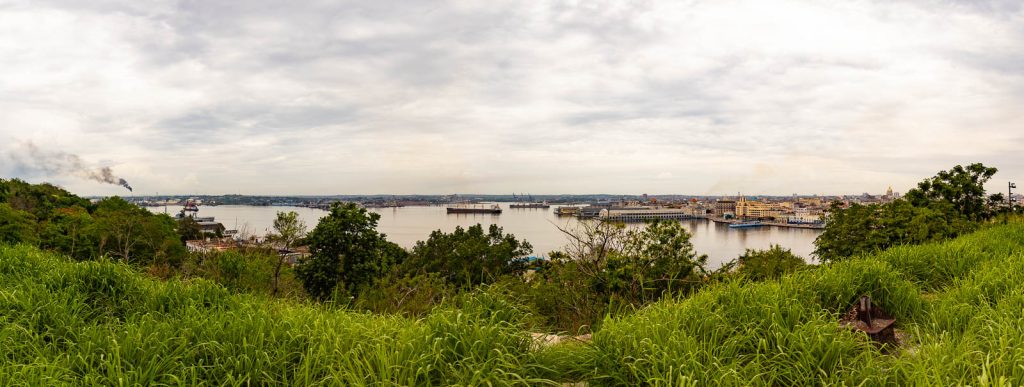
A caution - This is NOT a first world nation
As a tourist in Cuba, make no mistake, you are more well off than ANYONE you meet in Cuba. Your wealth is what takes you there. The overwhelming majority of Cubans has never been out of the Country, and frankly – couldn’t dream of it. The Government works hard to control what can be read or seen and the internet – though now quite common and available – is limited to ensure that the people are not fully and well exposed to the ‘outside’ views of Cuba.
You are travelling in Cuba’s world view, and while the people likely share our perceptions of the country, criticism of the Government or leadership is stifled with the law. Dissent is whispered over drinks – and never in ear-shot of management or a government employee or official. Behind closed doors – they are critical of the current situation, and powerless to change it – outside another (shhh..) revolution.
The Canadian government currently ‘discourages’ travel to Cuba, as the hotels and tour operators fund the Cuban government.
I ask this question. If we do not support tourism in Cuba, and the Cuban government loses revenue from North American and Western European travellers, who funds the nation? Travel to Cuba does support the government. But it also gives us the opportunity to support the people we relate to during that travel. Twenty dollars goes a long way for someone in Cuba.
Do not expect a ‘resort experience’ in Cuba as you would in any other country. Even Mexico and the Dominican are light years ahead of Cuba. The hotels are well staffed with hard-working and warm people, but they are limited in their ability to match what many travellers expect. There are limited cleaning products, no new linens, no paint for touch ups, no replacement knobs or handles, no replacement shower heads, and no tubes of silicone caulking when seals start to break down and it could take weeks to replace light bulbs. There may not be any salt, pepper, or ketchup in the restaurants, but you’ll find staff willing to do anything that they CAN to help. Just don’t expect miracles.
Take it all in – revel in it.
Tips for Photography in Cuba
Even when travelling to Cuba as a ‘full-on’ tourist – there are no shortage of photo opportunities. From the vintage pre-revolution vehicles, to the ever-present dilapidated pre-revolution american construction, and now ill-maintained colonial architecture of the 19th century all over the country. Before you leave Canada – take time to look at the images of people that inspire you – you’ll have fresh ideas and a revived sense of seeing the images you want to take.
- People are generally accepting of tourists with cameras, but do note – if you are photographing an individual, or indeed are invited to photograph an individual, $5 or $10 is likely expected (in convertible currencies as I mentioned.)
- If you’re in Havana, or an urban space, keep your eyes moving. You don’t look where you are walking – you look up. Most buildings in these urban spaces are in decay – and not a day goes by without another concrete balcony falling off a building. It’s daily life in Havana and the locals know. They walk in the street. In addition – so much of daily life is on the upper stories and rooftops. You’ll see more of the people this way.
- Travel light. The daily temperature in winter is around 30c. Carrying a photo backpack in these temperatures is a nightmare scenario. I carried my Eos RP and a 24-105L and didn’t feel that I was ‘missing’ out by not bringing the 16mm or the 200mm.
- Bring extra camera batteries and a spare charger. Modern cameras like the RP use quite a bit of power. I would routinely drain 2 batteries a day, and access to power at the hotel was limited to only a few plugs.
- Have water. If you think you’ll drink a liter, bring two. Then, you’ll only wish you had brought three.
- Carry your camera OUTSIDE a Camera bag. If you are around the hotel, or on a bus-tour, the AC is cranked and you’ll enjoy consistent 19c. When you EXIT these places, your 19c camera will hit 30c and 90% humidity, turning all of your gear into a foggy mess. ensure you allow time for the equipment to warm up and de-fog (yes, sensors fog up too…) so that you don’t miss any moments!
- It is BRIGHT in Cuba. If you want landscapes – you’ll want to carry a set of neutral density filters to bring down the bright skies or risk blown out clouds.
- Lastly – bring MANY SD cards. I carried one card for every day I was in Cuba. Since internet is sketchy, and computers are bulky to travel with, I use a portable SD Card backup tool that allows me to have a safe backup in case I lose or damage either. The backup is in my suitcase, and the cards in my carry-on.
